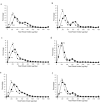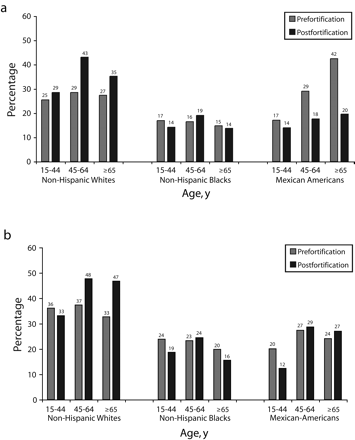Population-level changes in folate intake by age, gender, and race/ethnicity after folic acid fortification
- PMID: 17018833
- PMCID: PMC1751812
- DOI: 10.2105/AJPH.2005.067371
Population-level changes in folate intake by age, gender, and race/ethnicity after folic acid fortification
Abstract
Objectives: We sought to quantify the impact of the 1998 US Food and Drug Administration (FDA) folic acid fortification policy by estimating folate intake at the population level.
Methods: We analyzed total folate intake levels (from food and supplements) according to gender, age, and race/ethnicity, using data from 2 National Health and Nutrition Examination Surveys. We measured pre- and postfortification folate intake distributions, adjusted for measurement error, and examined proportions of the population who reached certain thresholds of daily total folate intake.
Results: Mean daily food and total folate intake increased by approximately 100 microg/day after fortification. The proportion of women aged 15-44 years who consume more than 400 microg/day of folate has increased since fortification, but has not yet reached the FDA's 50% target and varies by race/ethnicity from 23% to 33%. Among persons aged 65 years and older who may be at risk for masking a vita-microg/day (the min B12 deficiency, the percentage who consume more than 1000 "tolerable upper intake level") has at least doubled among Whites and Black men, but has remained less than 5% for all groups.
Conclusions: Since fortification, folic acid intake among the US population has increased, and there are substantial variations by age, gender, and race/ethnicity.
Figures



References
-
- Czeizel AE, Dudas I. Prevention of the first occurrence of neural-tube defects by periconceptional vitamin supplementation. N Engl J Med. 1992;327: 1832–1835. - PubMed
-
- Medical Research Council Vitamin Study Research Group. Prevention of neural tube defects: results of the Medical Research Council Vitamin Study. Lancet. 1991; 338:131–137. - PubMed
-
- US Food and Drug Administration. Folic acid fortification fact sheet: Office of Public Affairs. 1996. Available at: http://vm.dfsan.fda.gov/~dms/wh-folic.html. Accessed January 7, 2003.
-
- Johnston R, Staples D. Knowledge and use of folic acid by women of childbearing age—United States, 1997. MMWR Recommendations and Reports. 1997;46: 721–723. - PubMed
-
- US Food and Drug Administration. Food standards: amendment of standards of identity for enriched grain products to require addition of folic acid. Federal Register. 1996;61:8781–8797.
Publication types
MeSH terms
Substances
Grants and funding
LinkOut - more resources
Full Text Sources
Medical

